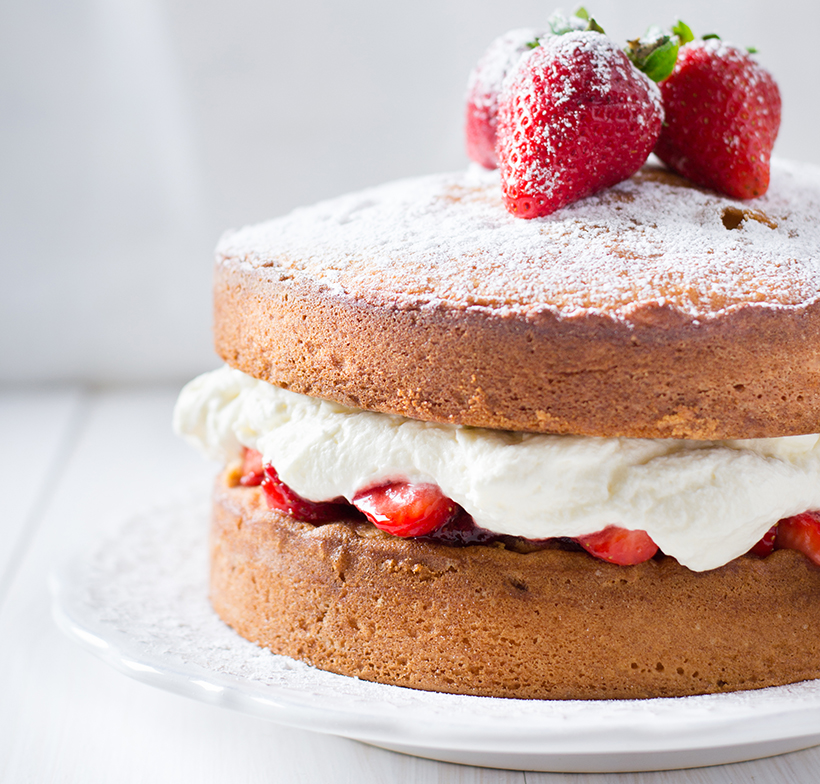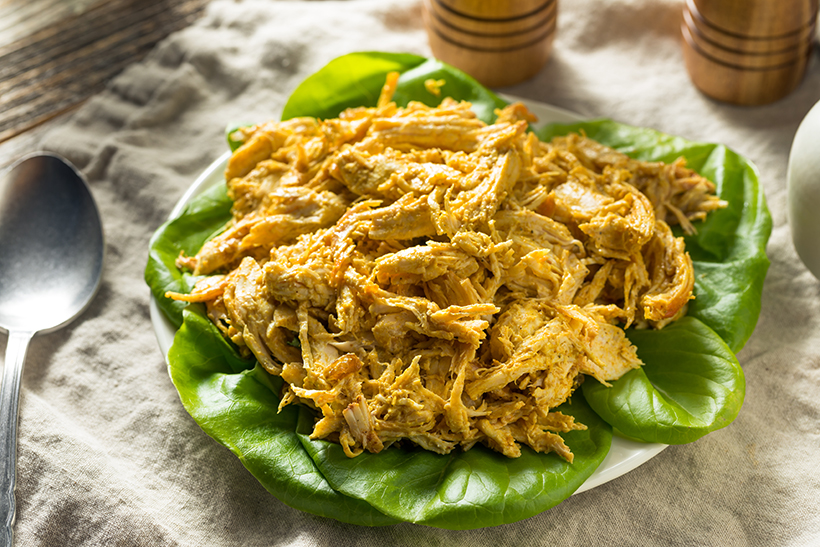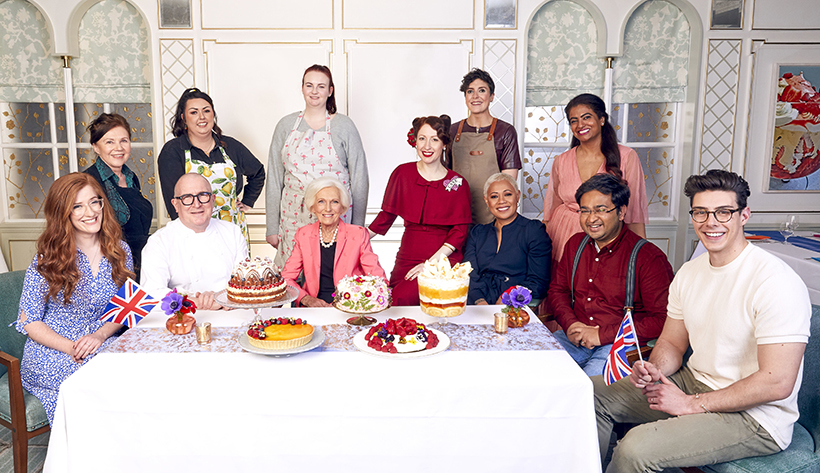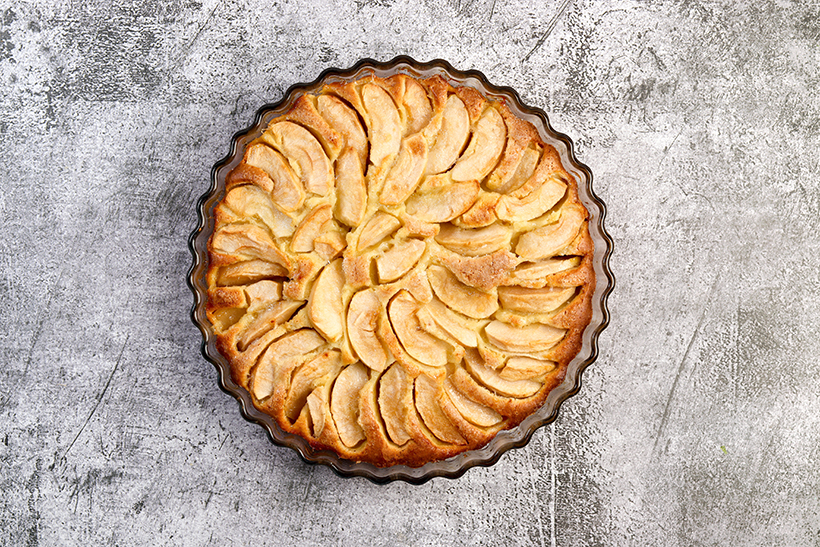As the country gears up to celebrate the Queen's Platinum Jubilee, The Caterer asks operators to share their memories of serving the royal household and looks back at the dishes that have made royal history
Marcus Wareing
Chef Marcus Wareing met the Queen at her 80th birthday in 2006, after winning the dessert course in the first series of the Great British Menu. The final was filmed at Her Majesty's 80th birthday banquet, where Wareing cooked his dessert – custard tart with Garibaldi biscuits – for the 300 guests.
"Afterwards, she met the four chefs – me included – in a line up as she was leaving the banquet hall. She spoke to all of us and I was last as I served the dessert. It was the highlight of the day.
"It was my first experience of meeting royalty and it was quite daunting. I got more and more nervous waiting for my turn after she spoke to Richard Corrigan, Bryn Williams and Nick Nairn. You meet a lot of people in life, but at the end of the day it's only when she's standing in front of you, that you think "bloody hell, that's the Queen of England!" It was a weird, ‘what-am-I-doing-here' moment, but it's something you never forget."
While Wareing described the exchange between him and the monarch as "short and sweet", he remembers her asking him about the inspiration for the dish. "The theme for the menu that year was regionality. I chose the custard tart – which is normally an individual tart you buy from a bakery in the north west – and I told her: ‘It's from where I'm from and it's as authentic as I am.' There are three elements – a pastry case, a custard and nutmeg – and you have to get the balance just right. It sounds simple, but it is very complex when you're developing the idea to sit as a slice. I served it with Garibaldi biscuits and it was like afternoon tea and biscuits, really."
The iconic dessert still gets asked for at Wareing's restaurants and will be available on his lunch menu at Marcus restaurant at the Berkeley throughout June.
"The dessert is very well known and people like it. It's been in a few of my cookbooks and on the menu, it's always a dish you could bring back. The Jubilee is a big occasion, so why not?"
Alan Baker-Green, food optimisation lead for ESS, part of Compass Group UK & Ireland
Throughout Alan Baker-Green's career, the chef has cooked for several members of the royal family, be that during his time with the Royal Navy or working with ESS. But the standout memory was in 2009, when he had the privilege of catering for the Queen when she attended a military base in Scotland to celebrate the inaugural Armed Forces Day.
At the time Baker-Green was executive chef for ESS and the logistics were complicated. The event took meticulous planning, including months of preparation with tasting menus, sourcing of local ingredients and bringing together a team of Compass and military chefs, as well as a front of house team from surrounding Compass units.
"The Queen was shown around the barracks, where there were displays put on, followed by a reception for 500 people and a VIP lunch in the warrant officers and sergeants' mess," says Baker-Green.
"At the canapé and drinks reception we served several options, including asparagus tips wrapped in pancetta on crostini and caramelised shallot and Cashel blue cheese shortbread. The starter for the Queen's lunch was a Scottish smoked salmon tian topped with horseradish crème fraïche and served with pink grapefruit lemon oil. The main course of roast Dornock Blackfaced lamb loin with seasonal veg was followed by an exceptional local cheeseboard that included home-made savoury biscuits and Scottish oatcakes."
Baker-Green recalls a "true sense of occasion in the air" with his team of chefs and front of house excited and proud to deliver the prestigious event.
"The day was a great success and an experience I will always look back on with great fondness," says Baker-Green. "A few years later, I did another event for the Queen and she selected a very similar menu from the options I provided, so I think she liked the food we created for her!"
Mark Alston, executive chef on Royal Yacht Britannia, the Queen's official yacht for over four decades
The ship was first assigned to the monarch in 1954 and travelled more than 1 million nautical miles around the world before finally berthing at Ocean Terminal in Leith, Edinburgh, in 1997. Today it is a major tourist attraction alongside its sister ship, the luxury floating hotel and restaurant Fingal, the kitchen of which Mark Alston also leads.
The chef, who worked at the Mandarin Oriental Hyde Park, London, before joining Britannia in 2008, has designed menus and prepared banquets for most of the royals from the confines of the yacht's galley kitchens.
Britannia's logistics are "a daily challenge", as the royal galleys have cambered decks, low ceilings and narrow corridors, but the chef says he and his team "find a way to make it work". Alston has catered for Prince Charles, Princess Anne, the Duke of Sussex and the Duke and Duchess of Cambridge on board ship, as well as celebrities such as Mariah Carey and Justin Timberlake.
In 2019, he created a meal for the Queen and her ladies-in-waiting aboard Fingal. It was a truly "proud moment", Alston tells The Caterer. When the chef informed friends and family he would be serving the monarch, "they were all over the moon. They thought it was the best thing in the world," he says.
Alston had designed Fingal's kitchens for its refurbishment, so they are easier to work from than Britannia's and run as a "well-oiled machine".
The Queen selected dishes from the ship's restaurant menu. Despite the highest of stakes, Alston says the experience "was not as nerve-wracking as you would expect from a chef's perspective. For a chef, the emphasis on the quality of the food is the same, whether it's for the royal family or for any guest," he says. "For the front of house staff who are out there serving them face-to-face, it's possibly more nerve-wracking. But that feeling you have inside that it's a great accolade stays there... It's a privilege."
He adds: "I think the key thing people have to realise about VIPs and royals is that they are quite easily pleased. They like simple food, local food, local produce – game or berries – just cooked simply. You'd think they would order foie gras and caviar, but it's not like that."
To coincide with the Jubilee celebrations, on 2 June Britannia will host an annual dinner for the Association of Royal Yachtsmen. Nicknamed the ‘Yotties', the association is made up of sailors who operated the ship when the Queen used it to travel around the globe on engagements. They will eat a meal in a mess-style kitchen prepared by a Royal Navy chef and Alston and his team will get to spend time with the veterans and hear their tales.
"They tell all the stories about when they were in service and met the Queen," the chef says. "It's always good."
Andrew Swann, executive chef, the Castle at Taunton, Somerset
"The Queen took a tour of the grounds at the Castle in 1987 while she was in Taunton to open the Queen's Building at Musgrove Park hospital.
"We wanted to do something special to mark the Jubilee, so we did some research into the Queen's Coronation banquet menu and found out that the TV series The Crown had recreated it but with some changes, based on the fact they filmed it in October and couldn't get English asparagus! We eventually found the original menu on the Royal Collection Trust website.
"The Coronation menu is a combination of popular dishes of the time and British classics using the best of seasonal produce. The naming of dishes after people and places seemed to have been in vogue at the time, but probably allowed chefs to create their own versions of classic dishes. The descriptions we found were also a little simple.
Obviously it was pretty easy to deduce what the rack of lamb would have involved, while other dishes such as the bôites de fraises reine Elizabeth were more abstract and we could play around with ideas a bit more. We decided to incorporate Pimm's into the dessert – the flavour works really well with the strawberries, while also celebrating a British product that is part of our culture.
"What's also great about the menu is that we're used to techniques such as making a consommé the proper way, which is something our younger team members may not have seen before. The skill set needed to produce this kind of food is what we used to learn from Larousse Gastronomique, but unfortunately isn't so widely taught nowadays.
Food trends may come and go, but classically prepared dishes using great quality produce that is treated with respect will always taste good.
The menu
- Coronation chicken canapé
- Tortue Claire Sandringham (mock turtle soup)
- Délices des soles Prince Charles (poached sole, shellfish mousse, bouillabaisse sauce)
- Carré d'Agneau à la Windsor, haricots verts au beurre, pommes nouvelles (rack of lamb, buttered green beans, new potatoes)
- Salade royale, aspêrges, sauce mousseline (crab beignet, asparagus, mousseline sauce)
- Boîtes de fraises reine Elizabeth (strawberry and Pimm's jelly, fresh strawberries)
- Friandises assorties (assorted sweets)
Claire Ptak, owner of Violet Cakes in east London
Claire Ptak made global headlines when she was selected to make the Duke and Duchess of Sussex's wedding cake in 2018.
She told The Caterer: "It was obviously pretty exciting, and it made me feel like ‘Oh, I made it!'. I came up with some of my favourite ideas considering the couple, the time of year and the magnitude of the occasion, then I brought them six cakes for a tasting. They chose their favourite, and we went from there." Ptak, who is known for her Californian-style cakes, made the couple a lemon and elderflower cake, which was served to guests at their wedding reception in Windsor Castle.
She added: "I wanted to be traditional while being innovative. I also wanted to do something seasonal. So I decided to make a modern cake with traditional stands, using their family heirlooms."
To mark the Platinum Jubilee she had developed a cake for the Standard hotel in King's Cross incorporating flavours believed to be favourites of the Queen. The dark chocolate cake, which stands at a metre tall, is spiked with blackcurrant-violet liquor and filled with a compote of English blackcurrants and a violet buttercream.
She said: "I did some research, and I don't know how true this is, but I've heard she is a real chocolate fan and likes to drink cassis. I also wanted to use blackcurrants because to me they are quintessentially British. And Violet is my favourite flower and our namesake, which also goes perfectly with chocolate and blackcurrant, so to me it felt like the perfect cake for such an iconic woman."
Ranjit Mathrani, director, Veeraswamy, London
Veeraswamy, London's oldest Indian restaurant, is well used to satisfying royalty as it can claim the King of Denmark and Prince Charles as regular patrons. It can also boast sharing a birthday with the Queen herself, since it first opened its doors in April 1926.
According to director Ranjit Mathrani that connection led to an approach to him and co-owners Namita and Camellia Panjabi to providing their celebrated Indian cuisine at Buckingham Palace.
"We have run two events at Buckingham Palace, in 2009 and 2017," he explains. "In 2009 it was a reception the Queen had in connection with the visit of the president of India, while in 2017 we served food at an event to launch the UK-India Year of Culture. To my knowledge 2009 was the first occasion the palace had outside caterers creating food for a reception."
The menu in 2017 included Raj puri; Tandoori prawn cocktail; salmon kedgeree croquette; Rajasthani soya samosas; and eclairs. It was prepared on-site by Veeraswamy chefs working alongside the Buckingham Palace brigade, led by royal chef Mark Flanagan.
"It ran like a military operation," Mathrani adds. "It all flowed seamlessly as all the work goes into it in advance. All of our chefs worked in the kitchens with Mark so it was a great experience.
"I recall being presented to the Queen before the head of [Indian multinational conglomerate] Tata. Someone quipped that if you serve food for the Queen you're in the top spot, and if you create 10,000 jobs you get second spot. But what struck me overall was the utter professionalism of the monarchy. They engaged everyone in the room with a great smile and a unique manner."
Edward Griffiths
As the former deputy master of the household, Edward Griffiths managed the delivery of hospitality operations within the occupied palaces, so has first-hand experience of the precision and planning that goes into every event.
He recalls the detail that went into events and receptions. "At a banquet held in St George's Hall at Windsor Castle, the single polished table for 166 persons takes days to prepare," he explains. "Each place setting is carefully measured to ensure that a view of the table is like a military procession. Nearly 5,000 pieces of gilt cutlery, crystal, china, candelabra and decorative pieces adorn the table.
"While after-dinner coffee is taken in the adjoining drawing rooms, the table is cleared within just over half an hour, leaving only the central candelabra and decoration pieces and flowers, so that the table is fully presentable again as guests walk through the hall again as they depart."
He continues his contact with the palace through work with the Gold Service Scholarship, which includes the Queen as a patron. It is designed to inspire and support the young hospitality leaders of the future and shine a light on talent, skills and opportunities in the front of house profession.
Griffiths adds: "In its support of the scholarship, since its inception, the Royal Household has shown great encouragement in the development and training of front of house service in food and beverage.
"Winning finalists from the scholarship enjoy the opportunity of work experience at royal garden parties, and the scholar is offered a work experience covering a state banquet at Buckingham Palace or Windsor Castle, or at a similar ceremonial event."
Griffiths co-authored the first royal cookbook with royal chef Mark Flanagan in 2014. The book concentrates on four seasonal menus, including as much produce as possible from the royal estates. The spring seasonal menu includes eggs Drumkilbo, one of the Queen Mother's favourite dishes, cutlets of Windsor lamb with green asparagus spears, new potatoes and sauce Paloise, and a blackcurrant sorbet.
Royal food: Victoria sponge
The Victoria sponge is a classic addition to any birthday tea, village fête, charity bake sale or street party. Any fans of The Great British Bake Off will be know that the key to a good Victoria sponge is a light and fluffy cake, which was only possible thanks to the invention of baking powder in the 1800s. It became a big hit with Queen Victoria, who was partial to a slice at afternoon tea, and was how the cake got its name. Today's Victoria sponge cakes contain raspberry jam and either freshly whipped cream or buttercream sandwiched between two light and fluffy sponge cakes – add a flurry of icing sugar and it's fit for the WI.
Royal food: Coronation chicken
Constance Spry, an English food writer, and Rosemary Hume, a chef, both principals of the Cordon Bleu Cookery School in London, are credited with the invention of Coronation chicken, prepared for the banquet of the Coronation of Queen Elizabeth II in 1953.
Poulet Reine Elizabeth, now widely known as Coronation chicken was created by the school 20 years after it opened its doors and was served at the Coronation banquet to 350 people in the Great Hall of Westminster school.
Some if the ingredients in the recipe were only just becoming available, whilst most of the country was still under the restrictions of post-war rationing.
Hume and Spry's Coronation Chicken (from The Constance Spry Cookery Book)
- 2 chickens
- 1tbs oil
- 50g onion, diced
- 1tsp curry powder
- 1tsp tomato purée
- 1 wineglass red wine
- ¾ wineglass water
- 1 bay leaf
- Salt, sugar, a touch of pepper
- A slice or two of lemon and a squeeze of lemon juice
- 1-2tbs apricot purée
- 450ml mayonnaise
- 2-3tbs lightly whipped cream
Poach the chickens in water with a little wine and bouquet garni for 40 minutes or so, until cooked thoroughly. Allow the chickens to cool before removing the meat from the bones and cutting into chunks. Heat the oil and cook the onion gently for 3 or 4 minutes. Stir in the curry powder and cook for another minute. Add the tomato purée, wine, water and the bay leaf. Bring the mixture to a boil. Add a pinch each of salt, sugar, and pepper, as well as the lemon slices and lemon juice. Leave the pan uncovered and allow to simmer for 10 minutes. Then strain the mix, keeping the liquid. Allow the liquid to cool.
Stir the apricot purée into the mayonnaise. Slowly add the cooled liquid, mixing as you go. Lastly, add the mixed cream to lighten the sauce texture. Combine the sauce with the chicken and serve with a rice salad.
Royal food: the official Jubilee pudding
Five home bakers battled to be crowned the winner of The Jubilee Pudding: 70 Years in the Baking competition which was televised on the BBC to mark the Queen's Platinum Jubilee.
Jemma Melvin's dessert of a lemon and Swiss roll amaretti trifle was the one to go down in history alongside the likes of the Victoria sponge as the official pudding to celebrate the Queen's 70-year reign. In the winning recipe, layers of lemon curd swiss roll, custard, jelly, mandarin coulis and amaretti biscuits make up the trifle, which was inspired by the lemon posset served at the Queen's wedding to Prince Philip.
Dame Mary Berry was joined by Roger Pizey, executive pastry chef of Fortnum & Mason, and MasterChef: The Professionals judge and chef-owner of Mere, Monica Galetti, to judge the competition.
Fellow judges also included author and baker Jane Dunn; Great British Bake-Off 2018 winner Rahul Mandal; culinary historian Regula Wsewijn; and pastry chef Matt Adlard, who all had to pick their favourite from desserts including a passion fruit tart, a bundt cake, a rose falooda and a four nations pudding.
Royal food: Apple Charlotte
The apple Charlotte is believed to take its name from Queen Charlotte, the wife of King George III, who, reports suggest, was a patron of apple growers.
Despite some reports to the contrary the British fruit Charlotte was created before Marie-Antoine Carême developed the charlotte à la Parisienne, which is prepared with cream, in the 19th century.
In the recipe slices of sugared apple are encased in buttered white bread in a pudding basin and baked. In her Complete Cookery Course Delia Smith says a true apple charlotte must be moulded in a basin, "so that when it's turned out the outside is crisp and buttery with the apples cooked to a pulp inside".
Royal food: Battenberg
Battenberg cake, with its distinctive yellow and pink checkered squares, is believed to have been created to celebrate the marriage of Prince Louis of Battenberg and Princess Victoria (granddaughter of Queen Victoria and grandmother to Prince Philip). The first recipe for the cake found in print is in Saleable Shop Goods by Frederick Vine, which dates to 1898.
In recent times it is typically made with four sponges, held together with apricot jam and wrapped in marzipan. However, it is believed the cake was originally made with Genoese sponges and would have contained more than four panels, with the changes being made as it was developed for commercial sale.
Continue reading
You need to be a premium member to view this. Subscribe from just 99p per week.
Already subscribed? Log In















